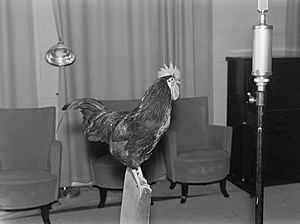Sound effect facts for kids

A sound effect is a special sound. It is used in movies, TV shows, video games, and music. Sound effects help make stories feel real. They can also make things more exciting or funny. We hear many sound effects every day without even noticing them!
What Are Sound Effects?
Sound effects are sounds added to media. They are not usually recorded when filming. Instead, they are made or found later. These sounds help create the right mood. They also make actions seem more believable. Imagine a superhero movie without the sound of punches or explosions!
How Are Sound Effects Made?
There are many ways to make sound effects. Some are created using everyday objects. Others are made with computers.
Foley Artists: The Sound Magicians
One cool way is through something called Foley. Foley artists are like sound magicians. They create sounds for movies and TV shows. They use simple objects to make complex sounds. For example, they might:
- Walk on different surfaces to make footsteps.
- Shake a sheet of metal for thunder.
- Crunch celery for bones breaking.
- Squeeze a wet sponge for squishy sounds.
- Hit a coconut shell for horse hooves.
Foley is named after Jack Foley. He was a sound pioneer in Hollywood. His work made movies sound much better.
Digital Sound Effects
Many sound effects today are made digitally. This means they are created or changed using computers. Sound designers use special software. They can record real sounds. Then, they change them to make new ones. They can also build sounds from scratch. This is how many sci-fi sounds are made. Think of laser blasts or alien voices.
Types of Sound Effects
Sound effects can be divided into different types. Each type serves a special purpose.
Hard Sound Effects
Hard sound effects are specific sounds. They are usually linked to an action. Examples include:
- A door slamming shut.
- A car horn honking.
- A phone ringing.
- A gun firing.
These sounds are often added in editing.
Soft Sound Effects
Soft sound effects are more general. They create an atmosphere. They might not be tied to one action. Examples are:
- Wind blowing.
- Rain falling.
- Birds chirping.
- Crowd murmurs.
These sounds help set the scene.
Background Sounds
Background sounds are also called "ambience." They are continuous sounds. They help show where a scene is taking place. For example, a city street scene might have sounds of traffic. A forest scene would have sounds of nature.
Designed Sounds
Designed sounds are unique. They are often made for specific things. These include:
- Spaceship noises.
- Monster roars.
- Magic spells.
These sounds don't exist in real life. They are created to fit the story.
History of Sound Effects
Sound effects have been around for a long time. They were used even before movies had sound.
Early Radio and Theater
In the early days, sound effects were live. They were made backstage in theaters. Radio shows also used live sound effects. Performers would make sounds right in the studio. This helped listeners imagine the story. For example, a person might crinkle cellophane for a crackling fire. Or they might use a thunder sheet for a storm.
The Rise of Talking Pictures
When movies got sound in the late 1920s, sound effects became even more important. At first, sounds were simple. But as technology improved, so did the sounds. Filmmakers could add more realistic noises. This made movies much more immersive.
Modern Sound Design
Today, sound design is a big part of making media. Sound designers work closely with directors. They help tell the story through sound. They use advanced tools. These tools help them create amazing soundscapes. Sound effects are now a key part of how we experience movies, games, and more.
Images for kids
-
A man recording the sound of a saw in the 1930s
See also
 In Spanish: Efecto de sonido para niños
In Spanish: Efecto de sonido para niños



